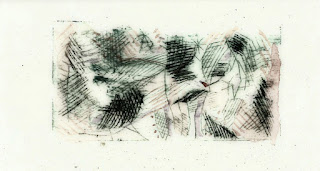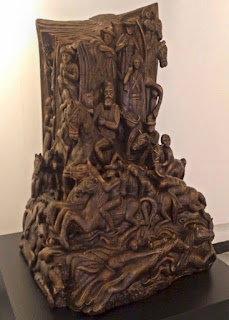A poet laureate (plural: poets laureate) is a poet officially appointed by a government or conferring institution, typically expected to compose poems for special events and occasions. Albertino Mussato of Padua and Francesco Petrarca (Petrarch) of Arezzo, both now part of Italy, were the first to be crowned poets laureate after the classical age, respectively in 1315 and 1342.
In Britain, the term dates from the appointment of Bernard André by Henry VII of England. The royal office of Poet Laureate in England dates from the appointment of John Dryden in 1668.
In ancient Greece, the laurel was used to form a crown or wreath of honour for poets and heroes. The custom derives from the ancient myth of Daphne and Apollo (Daphne signifying "laurel" in Greek), and was revived in Padua for Albertino Mussato, followed by Petrarch's own crowning ceremony in the audience hall of the medieval senatorial palazzo on the Campidoglio on April 8, 1341. Because the Renaissance figures who were attempting to revive the Classical tradition lacked detailed knowledge of the Roman precedent they were attempting to emulate, these ceremonies took on the character of doctoral candidatures.

Since the office of poet laureate has become widely adopted, the term "laureate" has come to signify recognition for preeminence or superlative achievement (cf. Nobel laureate). A royal degree in rhetoric, poet laureate was awarded at European universities in the Middle Ages. The term therefore may refer to the holder of such a degree, which recognized skill in rhetoric, grammar and language.
In modern times a Laureate title may be conferred by an organization such as the Poetry Foundation, which designates a Young People's Poet Laureate, unconnected with the United States Poet Laureate.
The office is also popular with regional and community groups. Examples include the Pikes Peak Poet Laureate,which is designated by a "Presenting Partners" group from within the community, the Minnesota Poet Laureate chosen by the League of Minnesota Poets (est. 1934), the Northampton Poet Laureate chosen by the Northampton Arts Council, and the Martha's Vineyard Poet Laureatechosen by ten judges representing the Martha's Vineyard Poetry Society.
Over a dozen national governments continue the poet laureate tradition.
Miguel Ángel Osorio Benítez (July 29, 1883 – January 14, 1942), better known by his pseudonym, Porfirio Barba-Jacob, was a Colombian poet and writer.
Born in Santa Rosa de Osos, Antioquia, to parents Antonio María Osorio and Pastora Benítez, he was raised by his grandparents in Angostura. In 1895 he started his travels, first through Colombia, and from 1907 to Central America and the United States, before finally settling down in 1930 in Mexico City.
Around 1902 in Bogotá, he founded the literary magazine "El cancionero antioqueño" (The Antioquian songbook), which he managed under the pseudonym Marín Jiménez. Short after, he wrote the novel "Virginia", which was never published because the original manuscript was confiscated by the mayor of Santa Rosa for alleged immorality.
In 1906 he moved to Barranquilla where he adopted the pseudonym Ricardo Arenales. He continued to use this pseudonym until 1922 when in Guatemala he adopted a new pseudonym which he would use for the rest of his life: Porfirio Barba-Jacob. Around 1907, still in Barranquilla, he wrote his first poems, such as "Árbol viejo", "Campiña florida", and his most famous work, "Canción de la vida profunda" (Song of the deep life).
During his journey through Central America, Mexico and the US, he contributed to many magazines and journals. He befriended Porfirio Díaz, which led to his fleeing to Guatemala, then to Cuba, for disagreeing with Manuel Estrada.
In 1918 he returned to Mexico, where it is said that he wrote a biography of Pancho Villa. In 1922 he was expelled by Álvaro Obregón and fled again to Guatemala, from where he was again expelled in 1924 by Jorge Ubico. Barba-Jacob then went to El Salvador, and after being deported by Alfonso Quiñones, travelled to Honduras, New Orleans and Cuba. In 1927 he returned to Colombia and, after some recitals and contributions to the Colombian journal El Espectador, he left Colombia on what would be his last trip.
He died in 1942 of tuberculosis in Mexico City. Four years after his death, on 11 January 1946, his ashes were claimed by the Colombian government and were returned to the Rotonda de los Hombres Ilustres.
Adolfo Cantú
ArtConsultant & Specialist FCG Copyright © CYDT©




















